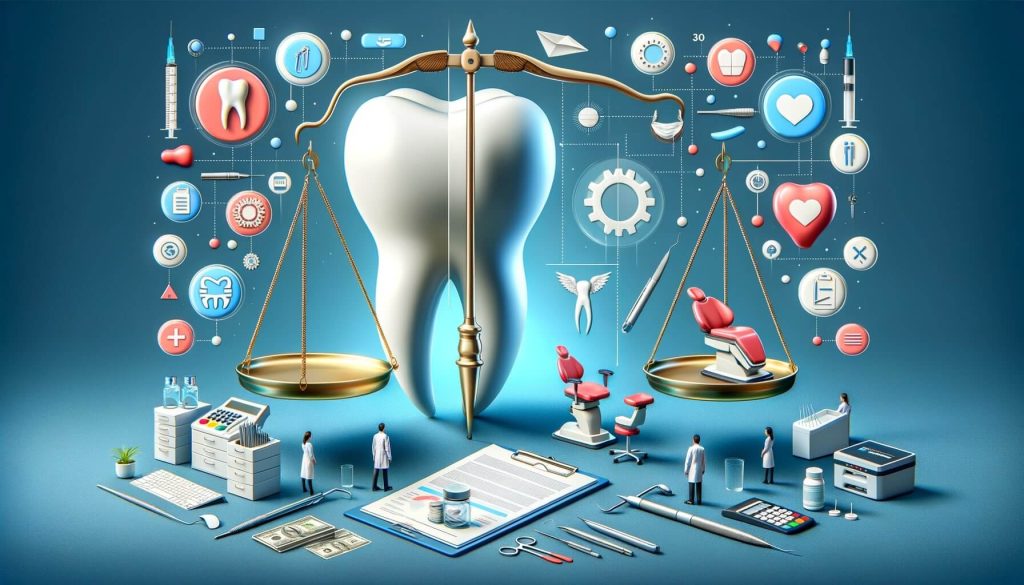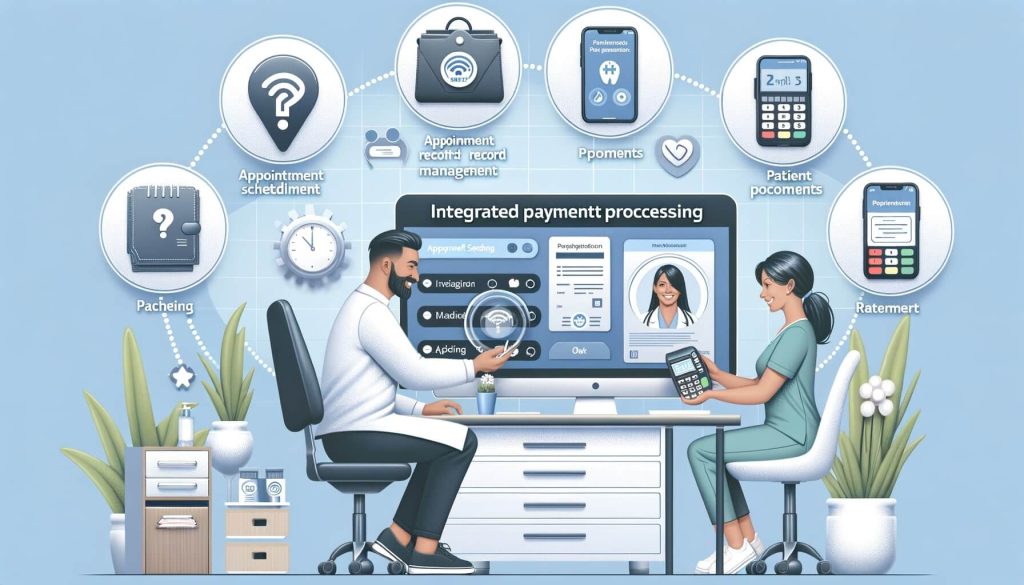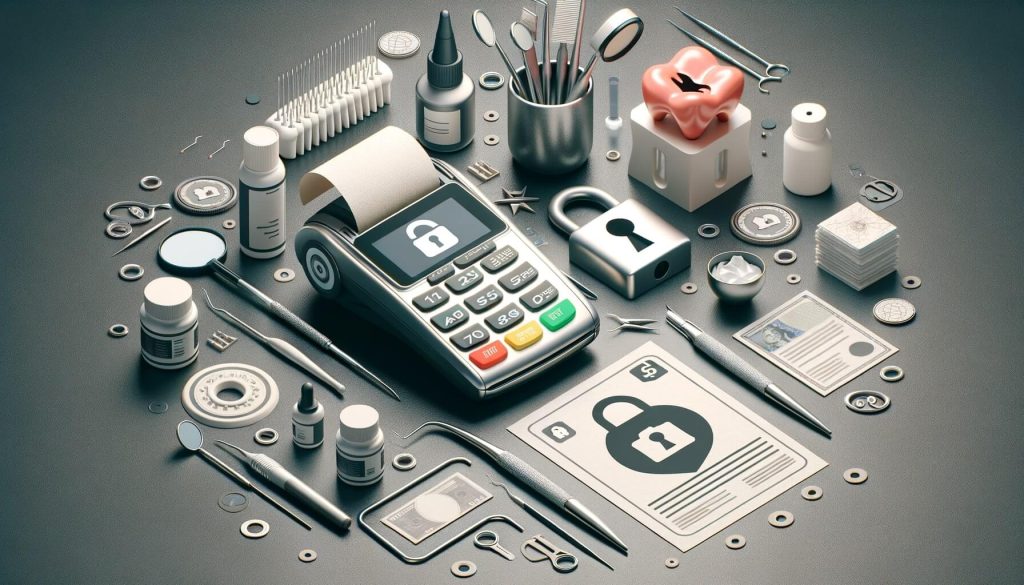In today’s digital age, the integration of payment processing into dental practice management software has become increasingly important. Dental practices are constantly seeking ways to streamline their operations, improve efficiency, and enhance the patient experience. By integrating payment processing into their software, dental practices can achieve all of these goals and more.
Payment processing refers to the handling of financial transactions, including the acceptance of credit and debit card payments, electronic funds transfers, and online payments. Traditionally, dental practices have relied on manual payment methods, such as cash or checks, which can be time-consuming and prone to errors. However, with the integration of payment processing into dental practice management software, practices can automate and streamline their payment processes, saving time and reducing the risk of errors.
Choosing the Right Payment Processing Solution for Your Dental Practice

Before integrating payment processing into your dental practice management software, it is crucial to choose the right payment processing solution. There are several factors to consider when selecting a payment processing solution for your dental practice:
1. Security: Security should be a top priority when choosing a payment processing solution. Look for a solution that is PCI-DSS compliant, which means it meets the highest security standards for handling credit card information.
2. Integration: Ensure that the payment processing solution seamlessly integrates with your dental practice management software. This will allow for a smooth and efficient payment process, eliminating the need for manual data entry and reducing the risk of errors.
3. Cost: Consider the cost of the payment processing solution, including any setup fees, transaction fees, and monthly fees. Compare different providers to find the most cost-effective solution for your dental practice.
4. Customer Support: Look for a payment processing provider that offers reliable customer support. In case of any issues or questions, it is important to have access to prompt and helpful support.
Integrating Payment Processing into Your Dental Practice Management Software: Step-by-Step Guide
Once you have chosen the right payment processing solution for your dental practice, it is time to integrate it into your practice management software. Here is a step-by-step guide to help you through the process:
Step 1: Assess your current payment processes: Before integrating payment processing, evaluate your current payment processes. Identify any pain points or inefficiencies that can be addressed through automation.
Step 2: Set up a merchant account: To accept credit and debit card payments, you will need to set up a merchant account with a payment processor. This account will allow you to securely process and receive payments.
Step 3: Configure your practice management software: Work with your software provider to configure your practice management software to integrate with the payment processing solution. This may involve installing plugins or APIs to enable seamless communication between the software and the payment processor.
Step 4: Test the integration: Before going live, thoroughly test the integration to ensure that payments are processed correctly and data is accurately recorded in your practice management software. Conduct test transactions and verify that all information is being captured and stored correctly.
Step 5: Train your staff: Provide comprehensive training to your staff on how to use the integrated payment processing system. This will ensure that everyone is familiar with the new process and can assist patients with making payments.
Step 6: Go live: Once you are confident in the integration and your staff is trained, it is time to go live with the integrated payment processing system. Communicate the changes to your patients and provide any necessary instructions for making payments.
Benefits of Integrating Payment Processing into Your Dental Practice Management Software

Integrating payment processing into your dental practice management software offers numerous benefits for both your practice and your patients. Here are some of the key advantages:
1. Improved efficiency: By automating payment processes, you can save time and reduce the risk of errors associated with manual data entry. Payments can be processed quickly and accurately, allowing your staff to focus on other important tasks.
2. Enhanced patient experience: Integrated payment processing provides a seamless and convenient payment experience for your patients. They can make payments using their preferred method, whether it is credit card, debit card, or online payment, without the need for manual paperwork or multiple visits to the office.
3. Increased revenue: Integrated payment processing can help you maximize revenue by offering flexible payment options to your patients. By accepting credit and debit card payments, you can attract more patients and increase the likelihood of receiving timely payments.
4. Streamlined financial management: With integrated payment processing, all payment data is automatically recorded in your practice management software. This eliminates the need for manual reconciliation and provides real-time visibility into your practice’s financials.
5. Improved security: Payment processing solutions that are PCI-DSS compliant offer advanced security features to protect sensitive patient information. This helps to build trust with your patients and ensures that their payment data is secure.
Common Challenges and Solutions in Integrating Payment Processing into Dental Practice Management Software

While integrating payment processing into dental practice management software offers numerous benefits, there can be challenges along the way. Here are some common challenges and their solutions:
1. Compatibility issues: Some payment processing solutions may not be compatible with certain practice management software. To overcome this challenge, choose a payment processor that offers seamless integration with your software or consider switching to a software provider that offers built-in payment processing capabilities.
2. Staff resistance to change: Introducing a new payment processing system may be met with resistance from staff members who are accustomed to the old way of doing things. To address this, provide comprehensive training and emphasize the benefits of the new system, such as time savings and improved efficiency.
3. Technical difficulties: Integration can sometimes be complex, and technical difficulties may arise during the process. To mitigate this, work closely with your software provider and payment processor to troubleshoot any issues and ensure a smooth integration.
4. Compliance requirements: Dental practices must comply with various regulations, such as HIPAA and PCI-DSS, when handling patient information and payments. Ensure that your payment processing solution meets all necessary compliance requirements to avoid any legal or security issues.
Ensuring Security and Compliance in Payment Processing for Dental Practices

Security and compliance are of utmost importance when integrating payment processing into dental practice management software. Dental practices handle sensitive patient information and must adhere to strict regulations to protect patient privacy. Here are some key steps to ensure security and compliance in payment processing:
1. Choose a PCI-DSS compliant payment processor: PCI-DSS (Payment Card Industry Data Security Standard) is a set of security standards that all businesses accepting credit card payments must adhere to. Choose a payment processor that is PCI-DSS compliant to ensure that your patients’ payment data is secure.
2. Encrypt payment data: Ensure that all payment data is encrypted during transmission and storage. Encryption adds an extra layer of security and protects sensitive information from unauthorized access.
3. Implement access controls: Limit access to payment processing systems and ensure that only authorized personnel can handle payment data. Implement strong passwords, two-factor authentication, and regular access reviews to prevent unauthorized access.
4. Train staff on security protocols: Provide comprehensive training to your staff on security protocols and best practices for handling payment data. This will help to minimize the risk of human error and ensure that everyone understands their role in maintaining security.
5. Regularly update software and systems: Keep your practice management software and payment processing systems up to date with the latest security patches and updates. Regularly review and update your security protocols to stay ahead of emerging threats.
Streamlining Financial Management with Integrated Payment Processing
Integrated payment processing can greatly streamline financial management for dental practices. By automating payment processes and integrating them with your practice management software, you can achieve greater efficiency and accuracy in financial management. Here are some ways integrated payment processing can streamline financial management:
1. Automated payment reconciliation: Integrated payment processing automatically reconciles payments with patient accounts, eliminating the need for manual reconciliation. This saves time and reduces the risk of errors associated with manual data entry.
2. Real-time financial reporting: With integrated payment processing, you have real-time visibility into your practice’s financials. You can generate reports on payments received, outstanding balances, and revenue trends, allowing you to make informed financial decisions.
3. Simplified billing and invoicing: Integrated payment processing allows you to generate and send invoices electronically, reducing the need for paper-based billing. This saves time and resources and improves the overall billing process.
4. Efficient accounts receivable management: Integrated payment processing provides a centralized view of all outstanding balances and allows you to easily track and manage accounts receivable. This helps to improve cash flow and reduce the risk of unpaid invoices.
Enhancing Patient Experience through Integrated Payment Processing
Integrated payment processing can greatly enhance the patient experience in dental practices. By offering convenient and flexible payment options, you can improve patient satisfaction and loyalty. Here are some ways integrated payment processing enhances the patient experience:
1. Multiple payment options: Integrated payment processing allows you to accept various payment methods, including credit cards, debit cards, and online payments. This gives patients the flexibility to choose their preferred payment method, making the payment process more convenient for them.
2. Contactless payments: With the rise of contactless payments, integrated payment processing enables dental practices to offer this option to their patients. Contactless payments provide a fast and hygienic payment experience, which is especially important in the current COVID-19 pandemic.
3. Online payment portals: Integrated payment processing can include online payment portals, where patients can securely make payments from the comfort of their own homes. This eliminates the need for patients to visit the office or send checks in the mail, making the payment process more convenient and efficient.
4. Automated payment reminders: Integrated payment processing can send automated payment reminders to patients, reducing the risk of missed or late payments. This helps to improve cash flow and ensures that patients are aware of their financial obligations.
Maximizing Revenue and Efficiency with Integrated Payment Processing
Integrated payment processing can help dental practices maximize revenue and improve overall efficiency. By offering convenient payment options and streamlining payment processes, practices can attract more patients and increase revenue. Here are some ways integrated payment processing can maximize revenue and efficiency:
1. Faster payment processing: Integrated payment processing allows for faster payment processing, reducing the time it takes to receive payments. This improves cash flow and ensures that revenue is received in a timely manner.
2. Reduced administrative tasks: By automating payment processes, integrated payment processing reduces the need for manual data entry and administrative tasks. This frees up staff time, allowing them to focus on more important tasks, such as patient care and practice growth.
3. Increased patient satisfaction: By offering convenient payment options and a seamless payment experience, integrated payment processing can improve patient satisfaction. Satisfied patients are more likely to refer others to your practice, leading to increased revenue.
4. Improved financial visibility: Integrated payment processing provides real-time visibility into your practice’s financials. You can easily track payments received, outstanding balances, and revenue trends, allowing you to make informed financial decisions and maximize revenue.
FAQs
Q1. Is integrating payment processing into dental practice management software secure?
Answer: Yes, integrating payment processing into dental practice management software can be secure if the right measures are in place. It is crucial to choose a payment processing solution that offers encryption, tokenization, and other security features to protect patient data. Additionally, ensure that the payment processing provider complies with industry regulations, such as HIPAA.
Q2. How can integrated payment processing improve cash flow management?
Answer: Integrated payment processing improves cash flow management by enabling real-time payment processing and reconciliation. Dental practices can track and reconcile payments more efficiently, reducing the risk of delayed or missed payments. This, in turn, improves revenue management and financial planning.
Q3. What payment methods should dental practices offer?
Answer: Dental practices should offer a variety of payment methods to cater to patient preferences. This may include credit cards, debit cards, electronic funds transfers, and mobile payment options. By offering multiple payment methods, dental practices can enhance the patient experience and reduce barriers to payment.
Q4. Can integrated payment processing help reduce errors in payment collection?
Answer: Yes, integrated payment processing can help reduce errors in payment collection. By automating the payment collection and reconciliation processes, dental practices can minimize mistakes such as incorrect payment amounts or misallocated payments. This ensures accurate financial records and reduces the risk of errors.
Q5. How can integrated payment processing enhance the patient experience?
Answer: Integrated payment processing enhances the patient experience by offering convenient payment options. Patients can make payments online or through mobile devices, eliminating the need for cash or checks. Additionally, integrated payment processing provides patients with access to their payment history and receipts through patient portals, empowering them to manage their financial transactions independently.
Conclusion
Integrating payment processing into dental practice management software offers numerous benefits for both dental practices and their patients. By automating payment processes, practices can save time, reduce errors, and improve overall efficiency. Patients benefit from a seamless and convenient payment experience, with multiple payment options and contactless payment capabilities.
Integrated payment processing also helps to maximize revenue, streamline financial management, and enhance the patient experience. By choosing the right payment processing solution, ensuring security and compliance, and following a step-by-step integration process, dental practices can successfully integrate payment processing into their software and reap the rewards.
